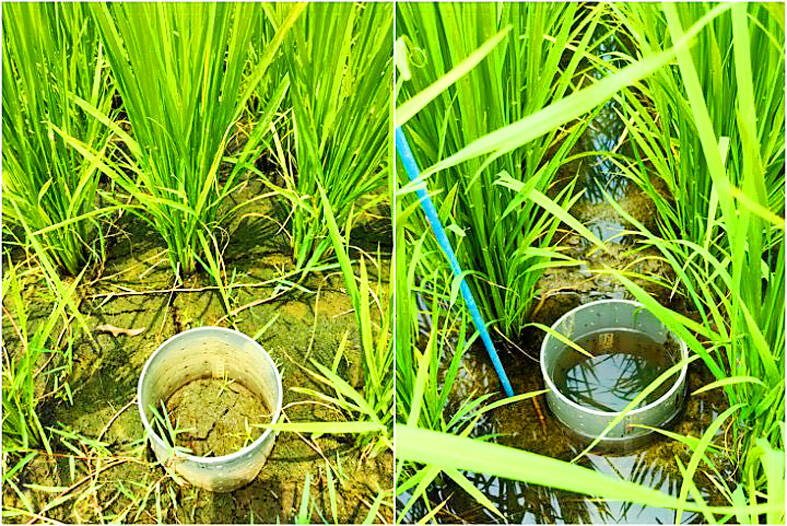The alternate wetting and drying (AWD) irrigation technique can reduce methane emissions from rice fields by 32.5 percent, while saving 21 percent of irrigation water, the Tainan District Agricultural Research and Extension Station said yesterday.
Flooding irrigation has been widely applied in Taiwan’s rice cultivation, but it can easily cause oxygen deficiency in soil and root suffocation, leading to akagare — or “suffocating disease” — that reduces both yield and quality, the station said.
By keeping farmland moist without constant flooding, AWD promotes stronger root development and lowers the risk of suffocation, it said.

Photo courtesy of the Tainan District Agricultural Research and Extension Station
Simulation results using the Denitrification-Decomposition model showed that the method can cut methane emissions by 32.5 percent and reduce water consumption by about 2,500 tonnes, or 21 percent, it added.
AWD assistant researcher Hsu Lung-hsin (許龍欣) yesterday said the AWD technique was initially introduced as a water-saving measure, but has since been found effective in reducing methane.
Microorganisms in oxygen-deprived conditions, such as flooded rice paddies, decompose organic matter and release large amounts of methane, she said, adding that AWD interrupts this process.
To apply the technique, farmers install a perforated tube with internal gradations to monitor water levels in the field, she said.
By digging into the tube with their fingers, they can check the underground water depth and determine when irrigation is needed, she added.
Although the original technique was developed by the International Rice Research Institute, which recommends irrigating when water levels fall to minus-15cm, the approach has proved unsuitable for Taiwan, as it reduces rice yields, Hsu said.
Most rice paddies in Taiwan have clayey soils that dry and crack if irrigation is delayed until minus-15cm, she said, adding that subsequent research found that irrigating at about minus-5cm is optimal for clayey soils in Taiwan.
Agricultural workers can easily make field water tubes themselves by purchasing polyvinyl chloride pipes from hardware stores, she said.
The tubes must be perforated so that the water levels inside and outside remain consistent, and farmland should be leveled in advance to ensure accurate measurements, she added.
Regarding irrigation frequency, fields with clayey soil typically require watering about once a week under the AWD system, while sandy soils might need irrigation as frequently as once a day, she said.

Taiwanese scientists have engineered plants that can capture about 50 percent more carbon dioxide and produce more than twice as many seeds as unmodified plants, a breakthrough they hope could one day help mitigate global warming and grow more food staples such as rice. If applied to major food crops, the new system could cut carbon emissions and raise yields “without additional equipment or labor costs,” Academia Sinica researcher and lead author the study Lu Kuan-jen (呂冠箴) said. Academia Sinica president James Liao (廖俊智) said that as humans emit 9.6 billion tonnes of carbon dioxide compared with the 220 billion tonnes absorbed

The Taipei Mass Rapid Transit (MRT) Wanda-Zhonghe Line is 81.7 percent complete, with public opening targeted for the end of 2027, New Taipei City Mayor Hou You-yi (侯友宜) said today. Surrounding roads are to be open to the public by the end of next year, Hou said during an inspection of construction progress. The 9.5km line, featuring nine underground stations and one depot, is expected to connect Chiang Kai-shek Memorial Hall Station to Chukuang Station in New Taipei City’s Jhonghe District (中和). All 18 tunnels for the line are complete, while the main structures of the stations and depot are mostly finished, he

Taipei is to implement widespread road closures around Taipei 101 on Friday to make way for large crowds during the Double Ten National Day celebration, the Taipei Department of Transportation said. A four-minute fireworks display is to be launched from the skyscraper, along with a performance by 500 drones flying in formation above the nearby Nanshan A21 site, starting at 10pm. Vehicle restrictions would occur in phases, they said. From 5pm to 9pm, inner lanes of Songshou Road between Taipei City Hall and Taipei 101 are to be closed, with only the outer lanes remaining open. Between 9pm and 9:40pm, the section is

China’s plan to deploy a new hypersonic ballistic missile at a Chinese People’s Liberation Army Rocket Force (PLARF) base near Taiwan likely targets US airbases and ships in the western Pacific, but it would also present new threats to Taiwan, defense experts said. The New York Times — citing a US Department of Defense report from last year on China’s military power — on Monday reported in an article titled “The missiles threatening Taiwan” that China has stockpiled 3,500 missiles, 1.5 times more than four years earlier. Although it is unclear how many of those missiles were targeting Taiwan, the newspaper reported